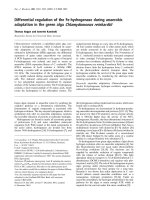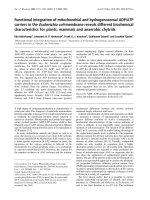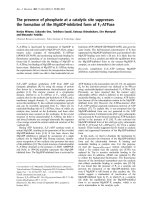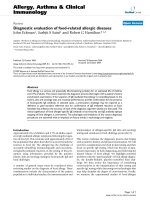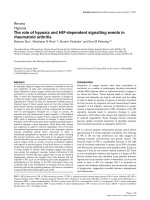Báo cáo y học: "Diagnostic value of antibodies against a modified citrullinated vimentin in rheumatoid arthritis" pptx
Bạn đang xem bản rút gọn của tài liệu. Xem và tải ngay bản đầy đủ của tài liệu tại đây (174.48 KB, 6 trang )
Open Access
Available online />Page 1 of 6
(page number not for citation purposes)
Vol 8 No 4
Research article
Diagnostic value of antibodies against a modified citrullinated
vimentin in rheumatoid arthritis
Christian Dejaco
1,2
, Werner Klotz
1
, Heike Larcher
1
, Christina Duftner
1
, Michael Schirmer
2
and
Manfred Herold
1
1
Clinical Department of Internal Medicine, Division of General Internal Medicine, Innsbruck Medical University, Anichstrasse 35, 6020 Innsbruck,
Austria
2
General Hospital of the Elizabethenians, Voelkermarkterstrasse 15-19, 9020 Klagenfurt, Austria
Corresponding author: Manfred Herold,
Received: 5 May 2006 Revisions requested: 31 May 2006 Revisions received: 20 Jun 2006 Accepted: 7 Jul 2006 Published: 19 Jul 2006
Arthritis Research & Therapy 2006, 8:R119 (doi:10.1186/ar2008)
This article is online at: />© 2006 Dejaco et al.; licensee BioMed Central Ltd.
This is an open access article distributed under the terms of the Creative Commons Attribution License ( />),
which permits unrestricted use, distribution, and reproduction in any medium, provided the original work is properly cited.
Abstract
Antibodies directed against citrullinated vimentin are members
of the family of autoantibodies reactive with citrullinated proteins
and are among the most specific serological markers for the
diagnosis of rheumatoid arthritis (RA). This study was performed
to test the diagnostic value of a newly developed enzyme-linked
immunosorbent assay (ELISA) for the detection of antibodies
against a genetically modified citrullinated vimentin (anti-MCV)
in comparison with a second-generation anti-cyclic citrullinated
peptides (anti-CCP2) ELISA test system. Blinded sera from 631
patients (409 consecutive out-patients and 222 randomly
selected stored sera) with RA (n = 164) and non-RA
(osteoarthritis [n = 120], polymyalgia rheumatica/giant cell
arteritis [n = 80], spondyloarthritis [n = 36], and other
inflammatory rheumatic or non-inflammatory disease [n = 67])
were tested for the presence of anti-MCV and anti-CCP2
antibodies according to the manufacturers' instructions. The
diagnostic performance of the anti-MCV was comparable with
the anti-CCP2 assay for the diagnosis of RA according to the
calculated area under the curve (0.824; 95% confidence
interval (CI) 0.778–0.870 versus 0.818; 95% CI 0.767–0.869)
as analysed by receiving operating characteristic curve. When
categorised with a cutoff value of 20.0 U/ml (as recommended
by the manufacturer), sensitivity and specificity of the anti-MCV
ELISA were 69.5% (95% CI 61.9%–76.5%) and 90.8%
(86.9%–93.8%), respectively, compared with 70.1% (62.5%–
77.0%) and 98.7% (96.7%–99.6%) of the anti-CCP2 assay.
Using the cutoff values of 19.0 U/ml and 81.5 U/ml for the anti-
MCV test to obtain a sensitivity and specificity identical to the
anti-CCP2 assay, showed a reduced specificity (89.8%;
85.8%–92.9%) and sensitivity (53.7%; 45.7%–61.5%),
respectively, of the anti-MCV ELISA compared with the anti-
CCP2 test. In conclusion, the serum ELISA testing for anti-MCV
antibodies as well as the anti-CCP-2 assay perform comparably
well in the diagnosis of RA. In the high-specificity range,
however, the anti-CCP2 assay appears to be superior to the
anti-MCV test.
Introduction
Rheumatoid arthritis (RA) is the most common inflammatory
joint disease, with a prevalence between 0.5% and 1% world-
wide [1]. In most patients, diagnosis of RA is based on the cri-
teria proposed by the American College of Rheumatology
(ACR) in 1987 consisting of clinical symptoms and radiologi-
cal findings, whereas the only laboratory test included is the
serum rheumatoid factor (RF) determination [2]. The ACR cri-
teria, however, were primarily developed as classification crite-
ria in established disease, and shortcomings in RA patients
with recent-onset disease have now become evident [3]. Cur-
rently available data suggest that the diagnosis of RA can ben-
efit from testing for antibodies to citrulline-containing peptides
such as antiperinuclear factors (APFs), antifillagrin antibodies,
antikeratin antibodies (AKAs), and anti-cyclic citrullinated pep-
tides (anti-CCPs) [4-7]. Due to practical inconvenience, APF
ACR = American College of Rheumatology; AKA = antikeratin antibody; anti-CCP = anti-cyclic citrullinated peptide; anti-MCV = anti-modified citrull-
inated vimentin; APF = antiperinuclear factors; AUC = area under the curve; CI = confidence interval; ELISA = enzyme-linked immunosorbent assay;
Ig = immunoglobulin; IgM-RF = immunoglobulin M-rheumatoid factor; OA = osteoarthritis; PMR/GCA = polymyalgia rheumatica and/or giant cell
arteritis; RA = rheumatoid arthritis; RF = rheumatoid factor; ROC = receiving operating characteristic; SD = standard deviation; SpA = spondyloar-
thritis.
Arthritis Research & Therapy Vol 8 No 4 Dejaco et al.
Page 2 of 6
(page number not for citation purposes)
was never introduced into clinical routine, whereas detection
of AKA by indirect immunofluorescence was among the main
laboratory tests used before anti-CCP enzyme-linked immuno-
sorbent assay (ELISA) kits became commercially available.
The anti-CCP ELISA is based on highly purified synthetic pep-
tides from dedicated libraries containing modified arginine res-
idues (citrulline) serving as antigens, has a specificity
comparable with AKA, and is more specific than APF and RF
testing [8-10].
Historically, anti-Sa antibodies were first identified in a French
Canadian patient whose name began with Sa. The reactivity of
these antibodies was found to be highly specific for RA [11].
Subsequent studies confirmed the high degree of RA specifi-
city, which exceeds 95%, in several populations tested [12-
15]. The sensitivity of this antibody varied with the stage of the
disease tested, ranging from 20%–25% in early RA cohorts to
47% in patients with more established disease [14,15]. The
Sa antigen, originally derived from placental tissue, has
recently been identified as citrullinated forms of vimentin
[11,16]. Vimentin is an intermediate filament that is widely
expressed in mesenchymal cells and macrophages and is eas-
ily detectable in synovium and fibroblast-like synoviocytes [17-
19]. In vivo, vimentin is usually not in a citrullinated state, but
deimination of this protein occurs in macrophages undergoing
apoptosis. Anti-citrullinated vimentin antibodies may then
emerge as a consequence of inadequate clearance of apop-
totic material in patients with RA [20].
In this study, we tested the value of a newly developed ELISA
for the detection of antibodies against a genetically modified
citrullinated vimentin (anti-MCV) in comparison with an anti-
CCP2-based ELISA system for the diagnosis of RA.
Materials and methods
Patients
Consecutive sera (n = 409) were obtained between October
2005 and February 2006 from patients visiting the rheumatic
outpatient clinic (Clinical Department of Internal Medicine) of
the Innsbruck Medical University (Innsbruck, Austria) and
stored until final use. Frozen sera (n = 222) from patients with
known inflammatory rheumatic diseases obtained between
2003 and 2005 were randomly selected and included in the
analysis. The final diagnosis was used as the reference stand-
ard and was obtained by chart review. Unclear cases were dis-
cussed by three investigators (C Dejaco, C Duftner, and MH)
and excluded if no definite diagnosis could be reached (Addi-
tional File 1). One hundred and sixty-four patients were diag-
nosed as having RA that met at least four out of the seven
criteria according to the 1987 ACR classification [2]. In the
rest of the cases, the following diagnoses were made: osteoar-
thritis (OA [n = 120]), polymyalgia rheumatica and/or giant cell
arteritis (PMR/GCA [n = 80]) [21], spondyloarthritis (SpA [n
= 36], including psoriatic arthritis [n = 10] [22], ankylosing
spondylitis [n = 9] [23], and colitis-associated/undifferenti-
ated SpA [n = 17]) [24], or other inflammatory rheumatic or
non-inflammatory disease (n = 67; connective tissue disease
[n = 12], crystal arthopathy [n = 4], fibromyalgia [n = 9],
mechanical back pain or enthesopathy [n = 29], virus infec-
tion-associated arthralgia [n = 6], and myelodysplastic syn-
drome [n = 7]). Demographic, clinical, and serological data of
patients with RA were obtained by chart review (Table 1).
Also, data on the serum levels of immunoglobulin (Ig) M-RF
(IgM-RF), which were routinely determined by a nephelometric
method (normal values 0–13 U/ml), were retrieved by chart
review. The mean ages of patients with RA and patients with
non-RA were 60.4 (± 12.0) and 58.5 (± 15.7) years (not sig-
nificant), respectively. In the RA group, there were slightly
more women (85.4%) than in the control group (76.2%; p =
0.026 according to the χ
2
test with Yates correction). Patients
with RA were under current treatment with single or combined
disease-modifying anti-rheumatic drugs (methotrexate [n =
95], leflunomide [n = 21], azathioprine [n = 3], sulfasalazine [n
= 13], hydroxychloroquine [n = 13], cyclosporine A [n = 2],
and Escherichia coli extract OM-89 [n = 8]) alone or in com-
bination with corticosteroids (n = 84), and tumour necrosis
factor-α blocking agents (infliximab [n = 2], etanercept [n = 6],
adalimumab [n = 10], or anakinra [n = 2]). No association was
found between disease duration and markers of disease activ-
ity (data not shown). The study was approved by the local eth-
ics committee. Written and informed consent was obtained
from each patient.
Table 1
Clinical characteristics of patients with rheumatoid arthritis (n
= 164)
Age 60.4 (12.0)
a
Female, n (%) 140 (85.4)
Disease duration (n = 153)
<1 year, n (%) 23 (15.0)
1–5 years, n (%) 45 (29.4)
>5 years, n (%) 85 (55.6)
DAS-28 (n = 69) 3.3 (1.5)
a
Swollen joint count (n = 137) 1 (0–23)
b
Tender joint count (n = 92) 1 (0–28)
b
Patients' global assessment (VAS) (n = 56) 23.2 (23.5)
a
ESR (mm/first hour) (n = 152) 28.8 (19.3)
a
CRP (mg/l) (n = 160) 13.9 (23.2)
a
IL-6 (pg/ml) (n = 74) 111.0 (292.2)
a
a
Mean (standard deviation).
b
Median (range). CRP, C-reactive
protein (normal values 0–6 mg/l); DAS, disease activity score; ESR,
erythrocyte sedimentation rate (normal values 0–10 mm/first hour);
IL-6, interleukin-6 (normal values 0–3 pg/ml); VAS, visual analogue
scale (range 0–100 mm).
Available online />Page 3 of 6
(page number not for citation purposes)
Anti-CCP2 and anti-MCV testing
Anti-MCV and anti-CCP2 testing was performed in an investi-
gator-blinded fashion. Anti-CCP2 antibody reactivity was
tested using a commercially available automated ELISA (EliA™
CCP Assay;Phadia GmbH, Freiburg, Germany) on a
ImmunoCAP100 automatic analyzer (Phadia AB, Uppsala,
Sweden) according to the manufacturer's recommendations.
Values of 10.0 U/ml or greater were considered to be positive.
Anti-MCV antibodies were measured using a recently
launched and now commercially available ELISA (kindly pro-
vided by ORGENTEC Diagnostica GmbH, Mainz, Germany)
according to the manufacturer's instructions [25]. In brief,
serum samples were diluted 1:100 and incubated on MCV-
coated microtiter wells for 30 minutes at room temperature on
a horizontal shaking platform (100/second). Plates were
washed three times and incubated with peroxidase-labeled
anti-human IgG-conjugate for 15 minutes. 3,3',5,5'-Tetrameth-
ylbenzidine substrate was incubated for 15 minutes after addi-
tional washing. Color development was stopped with 1 M HCl
solution, and the optical density of each well was measured
with an Anthos 2020 microwell photometer (Anthos Labtec
Instruments GmbH, Wals, Austria). Results are expressed in
U/ml using a simple point-to-point curve-fitting method. Values
of 20.0 U/ml or greater were considered to be abnormal
according to manufacturer's recommendations. This cutoff
was determined in a previous study of 232 healthy blood
donors performed by ORGENTEC Diagnostica GmbH and
comprises two standard deviations (SDs) of the mean anti-
MCV titer in this cohort (according to the user manual of the
anti-MCV ELISA provided by ORGENTEC Diagnostica GmbH
and personal communication).
Statistical analysis
Distributions of laboratory test results are described as the
percentage per category for qualitative items and as mean (±
SD) or median (and range) for quantitative items as stated. For
anti-CCP2 and anti-MCV, the receiving operating characteris-
tic (ROC) curve was constructed by plotting sensitivity against
one minus specificity (1 – specificity), varying the cutoffs
[9,26]. Diagnostic values of anti-MCV, anti-CCP2, and IgM-RF
are described as sensitivity and specificity with 95% confi-
dence interval (CI). To compare quantitative data, the Mann-
Whitney U and the Kruskal-Wallis tests (for multiple compari-
sons) were performed using the SPSS program, version 11.0
(SPSS Inc., Chicago, IL, USA).
Results
Patient characteristics
Sera from 631 patients were included in the study. All sera
were subjected to anti-MCV and anti-CCP testing. Sera from
170 patients (26.9%) were anti-MCV-positive (using the rec-
ommended cutoff value of 20.0 U/ml), whereas those from
137 (21.7%) tested positive in the anti-CCP2 assay (recom-
mended cutoff value of 10.0 U/ml). Anti-MCV and anti-CCP2
were significantly, but not perfectly, correlated with each other
(correlation coefficient = 0.594; p < 0.001 using Spearman's
rank correlation coefficient). In 467 patients, a definite clinical
diagnosis (164 patients with RA and 303 with non-RA) was
available, and thus these diagnoses were included in the final
analysis (Additional File 1). Data on IgM-RF were available in
415 (88.9%) out of these 467 patients, and 178 (42.9%)
were positive for IgM-RF.
Diagnostic value of anti-MCV and anti-CCP2 testing
Patients with RA had higher serum titers of anti-MCV antibod-
ies (median 101.0 U/ml; range 2–1,094) than patients with
OA (7.0 U/ml; 1–87), PMR/GCA (6.9 U/ml; 2–101), SpA (7.0
U/ml; 2–39), and other inflammatory rheumatic or non-inflam-
matory diseases (8.0 U/ml; 2–101; p < 0.001 for each com-
parison according to the Mann-Whitney U test).
For direct comparison of the diagnostic values of the anti-MCV
and the anti-CCP2 assays, we performed an ROC analysis.
The calculated area under the curve (AUC) was comparable
between the anti-MCV (0.824; 95% CI 0.778–0.870) and the
anti-CCP2 ELISA (0.818; 0.767–0.869) (Figure 1).
For comparing the sensitivity and specificity of the two tests,
we used not only the recommended cutoff value of 20.0 U/ml
for the anti-MCV ELISA, but also two additional cutoffs,
namely 19.0 and 81.5 U/ml. The results are summarised in
Figure 1
Comparison of the diagnostic values of the anti-modified citrullinated vimentin (MCV) and the anti-cyclic citrullinated peptide (CCP) 2 assayComparison of the diagnostic values of the anti-modified citrullinated
vimentin (MCV) and the anti-cyclic citrullinated peptide (CCP) 2 assay.
Receiver operating curves of the anti-MCV and (second-generation)
anti-CCP antibodies are shown. The sensitivity of each test is plotted
against one minus specificity for varying cutoffs (values lower than the
cutoff were considered negative, and other values were considered
positive) (n = 467).
Arthritis Research & Therapy Vol 8 No 4 Dejaco et al.
Page 4 of 6
(page number not for citation purposes)
Table 2. At the cutoff of 19.0 U/ml, both tests had an identical
sensitivity, but the specificity of the anti-MCV was reduced. In
contrast, when a cutoff of 81.5 U/ml was used in order to
obtain an equal specificity for both assays, the anti-MCV
ELISA demonstrated lower sensitivity than the anti-CCP2 test.
With respect to RA patients with recent onset of disease (<1
year; n = 23), the sensitivity of the anti-MCV (cutoff 20.0 U/ml)
and anti-CCP2 assays were both lower (62.5%; 40.6%–
81.2%) when compared with RA patients with established dis-
ease.
The diagnostic performances of the anti-MCV and the anti-
CCP2 tests were similar in the consecutive cohort that
included 49 patients with RA (29.9% out of all patients with
RA) and 223 patients with non-RA (73.6% out of all patients
with non-RA) compared with the total cohort, with a calculated
AUC of 0.809 (0.725–0.893) for the anti-MCV ELISA and
0.843 (0.765–0.922) for the anti-CCP2 test. With the recom-
mended cutoff values of 20.0 U/ml for the anti-MCV test and
10.0 U/ml for the CCP2 ELISA, both assays showed a sensi-
tivity of 65.3% (50.4%–78.3%) to detect patients with RA;
however, the specificity of the anti-MCV test (91.5%; 87.0%–
94.8%) was lower than that of the anti-CCP2 ELISA (98.7%;
96.1%–99.7%). Taking the cutoff value of 81.5 U/ml at which
the anti-MCV and the anti-CCP2 assays had identical specifi-
cities revealed the former assay to have lower sensitivity
(49.0%; 34.4%–63.7%) in comparison with the latter.
Sensitivity and specificity of IgM-RF testing for the diagnosis
of RA was 76.1% (68.6%–82.5%) and 77.7% (72.1%–
82.7%), respectively, whereas in patients with early disease,
IgM-RF revealed a sensitivity of 68.2% (45.1%–86.1%).
Discussion
There is growing evidence that therapeutic intervention early in
the course of RA leads to more efficient disease control, less
joint damage, and better prognosis of disease outcome.
Therefore, specific laboratory tests are desirable to help in the
early differentiation of RA and other forms of rheumatic joint
and connective tissue disease [14,27-29]. To date, a number
of reports have demonstrated the high diagnostic value of anti-
bodies directed against citrullinated proteins in the diagnosis
of RA. Although the specificity was more than 90% in most
studies, the sensitivity of the same antibodies varied between
33% and 87.2%, possibly reflecting diverse genetic back-
grounds and/or methodological differences in diverse antigen
preparations and detection techniques applied [30]. The diag-
nostic value of the anti-CCP2 test in this report was within the
range of these earlier publications [7].
Anti-citrullinated vimentin antibodies have previously been
detected in 23%–43% of patients with RA but in less than 8%
of patients with non-RA and healthy controls by immunoblot-
ting [11,13,15]. The objective of this study was to investigate
the diagnostic accuracy of a novel and commercially available
ELISA system for the detection of antibodies against a modi-
fied citrullinated vimentin (anti-MCV) in a large cohort of
patients with confirmed diagnoses of RA and non-RA in direct
comparison with the anti-CCP2 assay. As shown in Figure 1,
the ROC analysis revealed a comparable overall diagnostic
performance of the anti-MCV and anti-CCP2 ELISAs (AUCs
of 0.824 and 0.818, respectively). However, the curves of
both tests cross each other, and in the high-specificity range,
which is clinically of greatest interest, the anti-CCP2 assay is
the more sensitive test, whereas in the low-specificity range,
the anti-MCV ELISA has a higher sensitivity. Indeed, taking the
cutoff value of 81.5 U/ml to obtain identical specificity values
for both test systems, the sensitivity of the anti-MCV assay
(53.7%; 45.7%–61.5%) was significantly reduced (as the
95% CI did not include the corresponding sensitivity of the
anti-CCP2 test). Using the cutoff of 19.0 U/ml with identical
sensitivities of both assays resulted in a lower specificity of the
anti-MCV test (89.8%; 85.8%–92.9%) compared with results
from previous reports of anti-citrullinated vimentin and the anti-
CCP2 assay [31]. Because a consecutive cohort of patients
best reflects the number of patients with RA and non-RA seen
in clinical routine, we analysed the performance of the anti-
MCV test in this group separately. However, the diagnostic
performance of the anti-MCV and anti-CCP2 ELISAs in this
consecutive group did not differ from that in the entire cohort.
In patients with early course of disease, the sensitivity of the
anti-MCV ELISA was lower at the recommended cutoff of 20.0
U/ml compared with those with long-standing RA but was
equivalent to that of the anti-CCP2 test, detecting 62.5% of
patients with RA. Previous studies reported anti-CCP antibod-
ies in 47%–63% of patients with recent-onset RA, whereas
anti-citrullinated vimentin antibodies have been reported in
only one fifth of RA patients with early disease by immunoblot-
ting [13,15], thus indicating a superior performance of the
anti-MCV ELISA in this early-disease group compared with the
immunoblotting technique [8,9,26,32]. Besides, the presence
Table 2
Comparison of sensitivity and specificity of the anti-modified
citrullinated vimentin and the anti-cyclic citrullinated peptide
test (n = 467)
Cutoff (U/ml) Sensitivity (%
[95% CI])
Specificity (%
[95% CI])
Anti-MCV 20.0
a
69.5 (61.9–76.5) 90.8 (86.9–93.8)
19.0
b
70.1 (62.5–77.0) 89.8 (85.8–92.9)
81.5
c
53.7 (45.7–61.5) 98.7 (96.7–99.6)
Anti-CCP2 10.0
a
70.1 (62.5–77.0) 98.7 (96.7–99.6)
a
Recommended by the manufacturer. Cutoff with identical
sensitivity
b
and specificity
c
compared with the anti-CCP2 test,
respectively.
anti-CCP2, second-generation anti-cyclic citrullinated peptide; anti-
MCV, anti-modified citrullinated vimentin; CI, confidence interval.
Available online />Page 5 of 6
(page number not for citation purposes)
of anti-CCP antibodies has been shown to precede clinical
onset of RA, and one might speculate that anti-MCV antibod-
ies are also present in pre-disease serum samples [33]. There-
fore, we cannot exclude the possibility that some of our anti-
MCV (high)-positive patients without RA might develop RA in
the future. In that case, the true degree of specificity of anti-
MCV testing in this cohort might be underestimated [1].
The major limitations of our study are the small number of RA
patients with early disease (n = 23) and the lack of follow-up
data of the patients with non-RA. Prospective studies address-
ing the course of patients with undifferentiated early arthritis
and long-term follow-up of the anti-MCV-positive patients with
non-RA are necessary to evaluate the prognostic and diagnos-
tic value of this test for patients with early RA. Because chart
reviews partially lacked data of acute-phase reactants and clin-
ical assessments, we did not investigate possible associations
of the anti-MCV titer and other laboratory parameters and the
clinical disease activity. Also, comparisons of the diagnostic
value of anti-MCV with IgM-RF should be interpreted with cau-
tion due to the retrospective and incomplete retrieval of the
IgM-RF. The sensitivity and specificity of IgM-RF in our present
study are nevertheless consistent with published data [7].
Conclusion
Autoantibodies to citrullinated proteins are specific for the
diagnosis of RA. The anti-MCV ELISA is a novel, commercially
available test system for the detection of antibodies directed
against a modified citrullinated vimentin that demonstrates
comparable overall diagnostic performance in relation to the
anti-CCP2 assay according to the ROC analysis, with the cal-
culated AUCs of 0.824 versus 0.818, respectively. In the high-
specificity range of both tests, which is clinically the most rel-
evant, the anti-CCP2 ELISA appears to be superior to the anti-
MCV assay.
Competing interests
The authors declare that they have no competing interests.
Authors' contributions
C Dejaco, C Duftner, MS, and MH diagnosed and treated the
patients. MH, C Dejaco, HL, and C Duftner designed the study
and performed the analyses. WK carried out the ELISAs. MS
helped to coordinate the study. All authors were involved in
drafting the manuscript and read and approved the final ver-
sion.
Additional files
Acknowledgements
This work was supported by Innsbruck Medical University, the 'Verein
zur Förderung der wissenschaftlichen Ausbildung und Tätigkeit von
Südtirolern an der Universität Innsbruck' (to C Dejaco), and the Tyrolean
Research Funds (to C Duftner).
References
1. Lawrence RC, Helmick CG, Arnett FC, Deyo RA, Felson DT, Gian-
nini EH, Heyse SP, Hirsch R, Hochberg MC, Hunder GG, et al.:
Estimates of the prevalence of arthritis and selected muscu-
loskeletal disorders in the United States. Arthritis Rheum
1998, 41:778-799.
2. Arnett FC, Edworthy SM, Bloch DA, McShane DJ, Fries JF, Cooper
NS, Healey LA, Kaplan SR, Liang MH, Luthra HS, et al.: The Amer-
ican Rheumatism Association 1987 revised criteria for the
classification of rheumatoid arthritis. Arthritis Rheum 1988,
31:315-324.
3. Visser H, le Cessie S, Vos K, Breedveld FC, Hazes JM: How to
diagnose rheumatoid arthritis early: a prediction model for
persistent (erosive) arthritis. Arthritis Rheum 2002,
46:357-365.
4. Sebbag M, Simon M, Vincent C, Masson-Bessiere C, Girbal E,
Durieux JJ, Serre G: The antiperinuclear factor and the so-called
antikeratin antibodies are the same rheumatoid arthritis-spe-
cific autoantibodies. J Clin Invest 1995, 95:2672-2679.
5. Girbal-Neuhauser E, Durieux JJ, Arnaud M, Dalbon P, Sebbag M,
Vincent C, Simon M, Senshu T, Masson-Bessiere C, Jolivet-Rey-
naud C, et al.: The epitopes targeted by the rheumatoid arthri-
tis-associated antifilaggrin autoantibodies are
posttranslationally generated on various sites of (pro)filaggrin
by deimination of arginine residues. J Immunol 1999,
162:585-594.
6. Schellekens GA, de Jong BA, van den Hoogen FH, van de Putte
LB, van Venrooij WJ: Citrulline is an essential constituent of
antigenic determinants recognized by rheumatoid arthritis-
specific autoantibodies. J Clin Invest 1998, 101:273-281.
7. Herold M, Boeser V, Russe E, Klotz W: Anti-CCP: history and its
usefulness. Clin Dev Immunol 2005, 12:131-135.
8. Vallbracht I, Rieber J, Oppermann M, Forger F, Siebert U, Helmke
K: Diagnostic and clinical value of anti-cyclic citrullinated pep-
tide antibodies compared with rheumatoid factor isotypes in
rheumatoid arthritis. Ann Rheum Dis 2004, 63:1079-1084.
9. Saraux A, Berthelot JM, Devauchelle V, Bendaoud B, Chales G, Le
Henaff C, Thorel JB, Hoang S, Jousse S, Baron D, et al.: Value of
antibodies to citrulline-containing peptides for diagnosing
early rheumatoid arthritis. J Rheumatol 2003, 30:2535-2539.
10. Vossenaar ER, Venrooij WJ: Anti-CCP antibodies, a specific
marker for (early) rheumatoid arthritis. Clin Appl Immunol Rev
2004, 4:239-262.
11. Despres N, Boire G, Lopez-Longo FJ, Menard HA: The Sa sys-
tem: a novel antigen-antibody system specific for rheumatoid
arthritis. J Rheumatol 1994, 21:1027-1033.
12. Escalona M, Lopez-Longo FJ, Gonzalez CM, Monteagudo I, Rod-
riguez-Mahou M, Grau R, Carreno L: Anti-Sa sera from patients
with rheumatoid arthritis contain at least 2 different subpopu-
lations of anti-Sa antibodies. J Rheumatol 2002,
29:2053-2060.
13. Hueber W, Hassfeld W, Smolen JS, Steiner G: Sensitivity and
specificity of anti-Sa autoantibodies for rheumatoid arthritis.
Rheumatology 1999, 38:155-159.
14. Goldbach-Mansky R, Lee J, McCoy A, Hoxworth J, Yarboro C,
Smolen JS, Steiner G, Rosen A, Zhang C, Menard HA, et al.:
Rheumatoid arthritis associated autoantibodies in patients
with synovitis of recent onset. Arthritis Res 2000, 2:236-243.
15. Hayem G, Chazerain P, Combe B, Elias A, Haim T, Nicaise P,
Benali K, Eliaou JF, Kahn MF, Sany J, et al.: Anti-Sa antibody is an
accurate diagnostic and prognostic marker in adult rheuma-
toid arthritis. J Rheumatol 1999, 26:7-13.
The following Additional file is available online:
Additional File 1
A TIFF file showing a flow chart of enrolment and
outcomes.
See />supplementary/ar2008-S1.tiff
Arthritis Research & Therapy Vol 8 No 4 Dejaco et al.
Page 6 of 6
(page number not for citation purposes)
16. El-Gabalawy HS, Wilkins JA: Anti-Sa antibodies: prognostic and
pathogenetic significance to rheumatoid arthritis. Arthritis Res
Ther 2004, 6:86-89.
17. Ota F, Maeshima A, Yamashita S, Ikeuchi H, Kaneko Y, Kuroiwa T,
Hiromura K, Ueki K, Kojima I, Nojima Y: Activin A induces cell pro-
liferation of fibroblast-like synoviocytes in rheumatoid arthri-
tis. Arthritis Rheum 2003, 48:2442-2449.
18. Marinova-Mutafchieva L, Taylor P, Funa K, Maini RN, Zvaifler NJ:
Mesenchymal cells expressing bone morphogenetic protein
receptors are present in the rheumatoid arthritis joint. Arthritis
Rheum 2000, 43:2046-2055.
19. Xue C, Takahashi M, Hasunuma T, Aono H, Yamamoto K, Yoshino
S, Sumida T, Nishioka K: Characterisation of fibroblast-like cells
in pannus lesions of patients with rheumatoid arthritis sharing
properties of fibroblasts and chondrocytes. Ann Rheum Dis
1997, 56:262-267.
20. Vossenaar ER, Radstake TR, van der Heijden A, van Mansum MA,
Dieteren C, de Rooij DJ, Barrera P, Zendman AJ, van Venrooij WJ:
Expression and activity of citrullinating peptidylarginine deim-
inase enzymes in monocytes and macrophages. Ann Rheum
Dis 2004, 63:373-381.
21. Bird HA, Esselinckx W, Dixon AS, Mowat AG, Wood PH: An eval-
uation of criteria for polymyalgia rheumatica. Ann Rheum Dis
1979, 38:434-439.
22. Wright V, Moll JMH: Psoriatic arthritis. In Seronegative Polyar-
thritis Edited by: Wright V, Moll JMH. Amsterdam: North Holland
Publishing Company; 1976:169-223.
23. van der Linden S, Valkenburg HA, Cats A: Evaluation of diagnos-
tic criteria for ankylosing spondylitis. A proposal for modifica-
tion of the New York criteria. Arthritis Rheum 1984,
27:361-368.
24. Dougados M, van der Linden S, Juhlin R, Huitfeldt B, Amor B, Calin
A, Cats A, Dijkmans B, Olivieri I, Pasero G, et al.: The European
Spondylarthropathy Study Group preliminary criteria for the
classification of spondylarthropathy. Arthritis Rheum 1991,
34:1218-1227.
25. Egerer K, Bang H, Lathke K, Gauliard A, Feist E, Rudolph PE, Berg
W, Burmester GR: A new powerful marker for the diagnosis
and prognosis of rheumatoid arthritis – anti-CVM (anti-citrulli-
nated vimentin mutated) antibodies [abstract]. Arthritis Rheum
2005, 52(Suppl S):S118.
26. Dubucquoi S, Solau-Gervais E, Lefranc D, Marguerie L, Sibilia J,
Goetz J, Dutoit V, Fauchais AL, Hachulla E, Flipo RM, et al.: Eval-
uation of anti-citrullinated filaggrin antibodies as hallmarks for
the diagnosis of rheumatic diseases. Ann Rheum Dis 2004,
63:415-419.
27. Egsmose C, Lund B, Borg G, Pettersson H, Berg E, Brodin U,
Trang L: Patients with rheumatoid arthritis benefit from early
2nd line therapy: 5 year followup of a prospective double blind
placebo controlled study. J Rheumatol 1995, 22:2208-2213.
28. Quinn MA, Emery P: Potential for altering rheumatoid arthritis
outcome. Rheum Dis Clin North Am 2005, 31:763-772.
29. Symmons DP, Jones MA, Scott DL, Prior P: Longterm mortality
outcome in patients with rheumatoid arthritis: early presenters
continue to do well. J Rheumatol 1998, 25:1072-1077.
30. Mimori T: Clinical significance of anti-CCP antibodies in rheu-
matoid arthritis. Intern Med 2005, 44:1122-1126.
31. Menard HA, Lapointe E, Rochdi MD, Zhou ZJ: Insights into rheu-
matoid arthritis derived from the Sa immune system. Arthritis
Res 2000, 2:429-432.
32. Raza K, Breese M, Nightingale P, Kumar K, Potter T, Carruthers
DM, Situnayake D, Gordon C, Buckley CD, Salmon M, et al.: Pre-
dictive value of antibodies to cyclic citrullinated peptide in
patients with very early inflammatory arthritis. J Rheumatol
2005, 32:231-238.
33. Berglin E, Padyukov L, Sundin U, Hallmans G, Stenlund H, Van
Venrooij WJ, Klareskog L, Dahlqvist SR: A combination of
autoantibodies to cyclic citrullinated peptide (CCP) and HLA-
DRB1 locus antigens is strongly associated with future onset
of rheumatoid arthritis. Arthritis Res Ther 2004, 6:R303-308.



